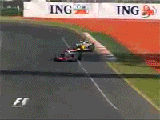f1.redbaron wrote:I have a very simple question which, I'm sure, doesn't have a simple answer...the question is, what can be done to improve the situation on the roads? I don't know about you, but I'm getting a little tired of the traffic jams, accidents, etc.
This is the proverbial good question. Like all engineering answers, it has many parts. I’m copying and pasting things I’ve written before: I tried to be brief, I swear.

Traffic is a public service that is treated differently of other public utilities. If your home's electric voltage is low because there are too many people connected, or if you get an eternal busy tone on your phone because your telephone exchange is overwhelmed by calls, you won't display the patience you have on traffic jams.
The worst traffic jams in the world involve no cars: arguably, the Panama Canal or the Jamarat Bridge during the Hajj, in the picture below, dispute the first place (the "gray river" is the people).

To add insult to injury, they occur day after day at the same spots, contaminating the city, wasting a sizeable amount of the oil used in transportation, costing you money directly from your pocket, converting the city you live on, your very "vital space", into an ugly thing.
Figures for 4 designs at a particular crossing in Bogotá. You can see the intersection as a huge machine that uses lots of fuel: 18.000 gallons per day vs 13.000 gallons per day after final design. Figures given are for the 15 peak minutes of the day: notice how you can increase distance travelled by 200%, increase speed by 300% and reduce fuel and contamination to 60% of the do-nothing option.
Code: Select all
Parameter Units Do nothing 1st 2nd 3rd Final
Total distance Miles 2,818 3,090 4,026 4,541 4,681
Total trips Trips 3,399 3,381 4,625 5,119 5,363
Ttl delay/mile Hrs-veh 374 367 139 133 112
Speed Mph 6.3 7.0 16.8 18.4 20.4
Ttl fuel used Gallons 536 481 422 415 383
CO2 emissions Gr/mile 339 314 246 241 232

Let’s face it, we have been raised to believe that traffic congestion is unavoidable, an “act of God”. One reason for this "public submission" is that the tools to avoid traffic jams have been developed during my life, not before. It's my personal opinion that not too many cities "do it right". Actually, you should have elected officials with clear goals about it, but I'm getting ahead of myself.
Apparently, people recognizes that traffic congestion is a tremendous waste of resources for a country but they are resigned to live with it.

Another reason is that other public utilities are "compartmentalized" through valves and switches, while roads aren't: A traffic jam at a particular intersection can spread quickly to the entire local sub-network. Imagine that an electric surcharge in Brussels could bring low voltage in Paris and you’ll get the idea of the problem of integration of the system. Traffic networks have a "no prisoners taken", or bimodal approach: either they are OK or they are terribly wrong.
Let's talk only of urban networks, rural ones are different. I use examples taken from Bogotá's situation, because in my town we have tried every trick that I know. The case is that you have a fixed network and a fluctuating demand and you find that you have excess of demand only at peak times. What can you do?
Well, to answer the question, you can do two things about it:
1. Attack the origin of the traffic congestion
It has the best benefit/cost ratio, but it takes longer to implement. There are three main tools available:
- Zoning laws
- Full urban planning
- Mandatory traffic studies
Your first problem usually resides in the
zoning plan of the city. This plan takes the form of a precise map that shows, for each lot in the city, what you can build on it. It also gives you "densities", or the importance of constructions allowed at each zone, being either 100 floors buildings or two-story houses.
Territorial Ordering Plan for Bogotá (yes, I know, funny name: probably it's my translation). I followed SimCity's conventions  : green for residential areas, blue for commercial ones and orange for industrial zones, the darker the denser. In gray you see the "urban equipment", like airports, electric stations, schools, hospitals and the like. I used bright green for the parks and protected areas.
: green for residential areas, blue for commercial ones and orange for industrial zones, the darker the denser. In gray you see the "urban equipment", like airports, electric stations, schools, hospitals and the like. I used bright green for the parks and protected areas.
[iMG:349:490]
http://ciropabon.googlepages.com/BogotaZoning.jpg[/img]
Then you use your second tool: a full urban planning. You use a transportation model, the standard being "The Four Stages Method". You use TransCAD, VISUM, Tranus or something similar. First, from areas, densities and personal interviews or census forms, you deduce the "trip generation" at each area. Second, you estimate the movements between areas to reach an "origin-destination" matrix, showing how much people moves from one area to another.
Origin-destination matrix for Bogotá. It shows how many trips are made from a zone to another zone of the city.

Third, you calculate what transportation they use (car, bus, metro, whatever, we call that the “modal-split”). Fourth and final, you use some rules to “attribute” that people to the roads. This is your traffic model for the city. You end knowing the capacity you need at each road and you incorporate the design of each one in your “Territorial Plan”.
Bogotá’s main road network. The corridors have been calculated under the assumption that over 70% of all travels will use public transit and that the city will stop growing in 2040. Cities this size without public transportation require a much larger road network.

I believe Bogotá’s transit network has been an engineering success mainly because properly designed, exclusive transit lanes using heavy buses are much more effective than carpool or light metro lanes, carrying up to 300.000 people per day and costing roughly 1/8 of a rail system. On congested links you need a metro system.
Bogotá's Transmilenio heavy bus lines. Notice how the transit uses the center of the road. There are bikeways on the sides of the highway (the stars are Christmas decorations).

Let me remark how important is for the City Council to approve the traffic plan. The Territorial Plan states the size of all the main avenues, parks, transportation network and the such, and it is a law of the city: the Mayor can’t spend the money otherwise.
Finally, you must use
mandatory traffic studies for any new building or
traffic work. You use NETSIM or VIS or similar software. Whenever a builder wishes a permit for a mall, a warehouse or a modest size building, he has to present a study that shows how many people will “attract”. He has to calculate the impact on the congestion of the adjacent streets and pay from his own pocket the modifications needed. This way builders look for lots that don’t require that much infrastructure and they take somehow into consideration the “cost of traffic”. You can check my website, if interested.
I will continue later, if there is no oposition, with:
2. Attack the traffic jam itself. I have to sleep and this is already way too long.











